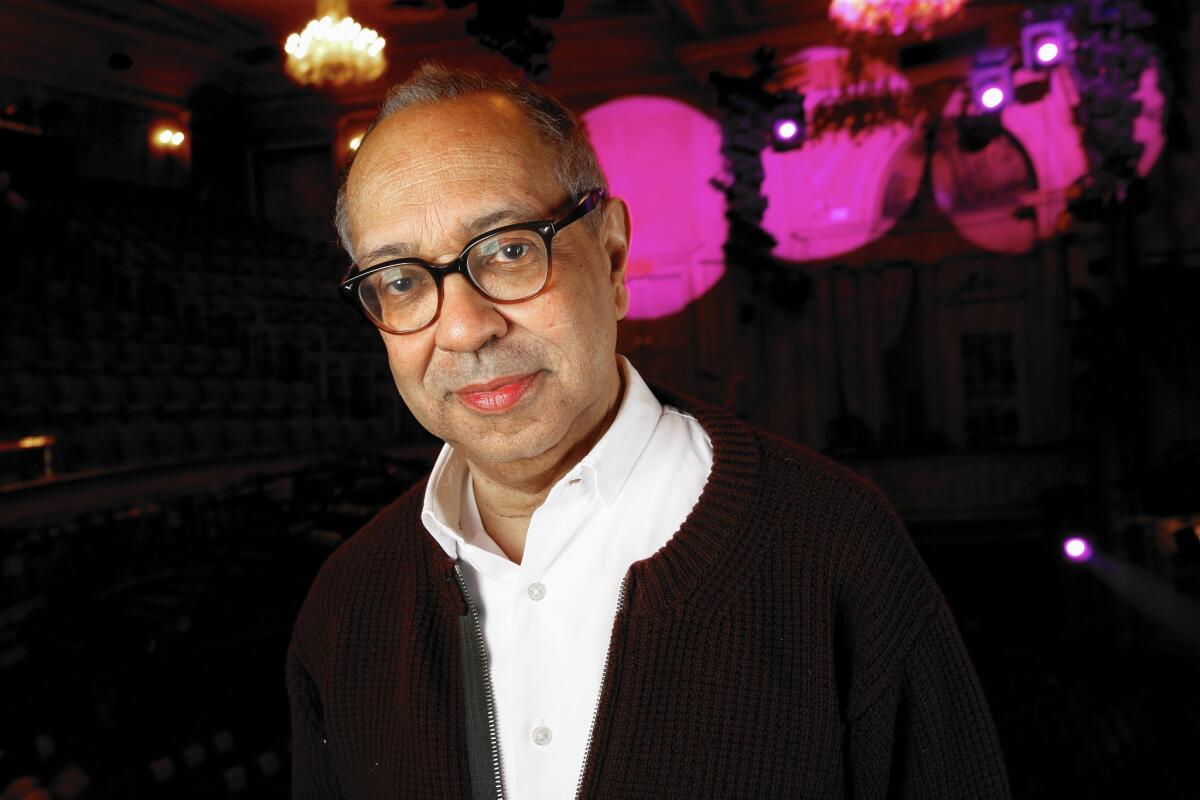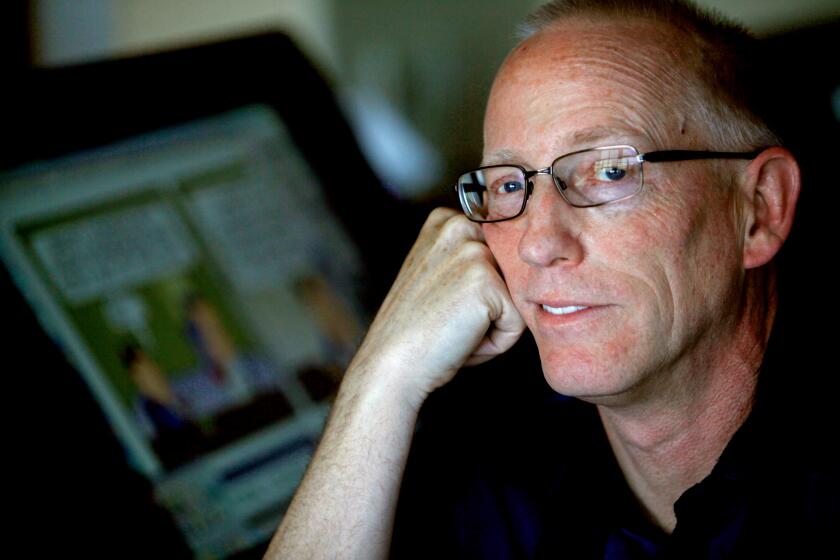How ‘Shuffle Along’ director George C. Wolfe brought back the 1921 show that changed Broadway forever

- Share via
NEW YORK — OK, theater buffs, get ready to be stumped. From what musical did “I’m Just Wild About Harry” spring?
If you answered “Shuffle Along,” you either have an encyclopedic memory (and way too many cast albums) or you’ve been reading about the new Broadway show that has been created from this long-forgotten black musical blockbuster of the Jazz Age.
Director George C. Wolfe, making quick work of a meal at the Music Box Theatre during a break in rehearsals for “Shuffle Along, or, the Making of the Musical Sensation of 1921 and All That Followed,” described what led him to adapt, stage and fill in the history of a show that changed Broadway forever but has been largely erased from cultural memory.
“Something huge happened and then something huge also happened — which was that we don’t know anything about it,” he said. “And I just became very intrigued by that dichotomy.”
In detective parlance, “Shuffle Along” represents a cold case, and Wolfe quite naturally became the private investigator of the mysterious disappearance of this historic African American extravaganza.
The show, which has a score by Eubie Blake and Noble Sissle and a book by the vaudeville comedy duo of F.E. Miller and Aubrey Lyles, became a landmark for turning Broadway audiences on to the syncopated rhythms of black music.
“Shuffle Along” enjoyed an long run for its era, created nightly traffic jams outside the theater and introduced audiences to the rising young talents of Paul Robeson, Florence Mills and a scene-stealing young chorus dancer named Josephine Baker, who was in one of the show’s road companies.
The musical also notably took up the charge for integration, permitting blacks to sit in the orchestra section alongside whites. What’s more, it unapologetically depicted amorous relations between black people, something considered taboo at the time.
Though true to the catch-as-catch-can tradition of ‘20s musical comedy, “Shuffle Along” did something radical that was instantly assimilated: It infused jazz into the sound of Broadway. The rhythm was so infectious that the chorus, whose theatrical function had been largely ornamental, turned strutting into hoofing.
Wolfe, who is resurrecting “Shuffle Along” with a dream team of black talent (including six-time Tony-winner Audra McDonald, Brian Stokes Mitchell, Billy Porter and Joshua Henry), learned about the show through a series of clues and cryptic mentions, mostly having to do with luminaries who passed through the cast at some point during its original run.
While a student at Pomona College, Wolfe became obsessed with Robeson, and this research led him to Mills, another replacement in the illustrious revolving-door cast who became an international star before her early death. And then there were the fans who became legends — Langston Hughes (who fell in love with the show as a freshman at Columbia University) and a quick-study George Gershwin, to say nothing of such redoubtable critics as Gilbert Seldes and George Jean Nathan, both of whom were bowled over.
In honoring the legacy of this show, Wolfe has reunited with a crucial member of his own theatrical past, Savion Glover, the revolutionary tap artist who was part of Wolfe’s signature Broadway successes, “Jelly’s Last Jam” and “Bring in ‘da Noise, Bring in ‘da Funk.” Serving as choreographer, Glover is tapping in, if you will, to his own rich knowledge of black dance.
“I call Savion a living repository of rhythm, because he was tutored by older tap dancers who were taught by older tap dancers who were taught by older tap dancers,” said Wolfe. “It’s all alive in him — in a way that’s visceral, vibrant and almost channeling-like.”
Wolfe explained that he wanted to remove “the performance equation” from Glover so that he could concentrate wholly and objectively on the choreography. The production is opting for a dance style that marries the old with the new. “It’s not a museum piece,” Wolfe said. “Everything’s got to feel vibrant, scenically, musically. It’s very interesting, because you want to honor what was, but everything that was gave birth to everything that is.”
It’s not clear whether “Shuffle Along,” one of this Broadway season’s most anticipated openings, will be classified by the Tony Awards Administration Committee as a new musical or a revival — a distinction that will have consequences in an awards season in which “Hamilton” is expected to clean up. Wolfe, who was careful in his remarks about how much of the original show is intact, had the frazzled look of a scientist being asked about his research findings while still pulling all-nighters in the lab.
The tortuous new title suggests that a new work has been built around the existing show. Wolfe said the tweaks to the original book were about translating the work for a modern sensibility, but since “Shuffle Along” hasn’t had a Broadway revival since 1952 (and that one lasted for only four performances), it is doubtful anyone will be able to tell the extent of the renovation.
Updated when it was previously revived, “Shuffle Along” is hardly a sacrosanct work. “It was a poor show,” Wolfe said. “They’d get costumes sent over from a trunk of a show that failed. If they’d get antebellum costume, they’d build a number around them, and if Oriental-looking costumes were sent over they’d build a number around those.”
Book writers Miller and Lyles performed in blackface, extending their vaudeville routine into their revue-like musical. Wolfe is fascinated by the theatrical dimension of this outdated convention (“it feels like commedia and kabuki theater to me”). Though fully cognizant of the racial baggage, he hopes that audiences will appreciate the wily expressiveness of the artistry.
The potluck quality of the material excites rather than worries Wolfe. “It was a book show, but it was a ‘20s book show, so periodically they’d stop for a number that had nothing whatsoever to do with anything you’d just seen,” Wolfe explained. “It’s the story of a mayoral election in a small Southern town, but — how can I describe it? It’s black vaudeville meets operetta meets Southern folkloric humor meets Ziegfeld Follies.”
Wolfe’s cast members play both the characters from “Shuffle Along” and the performers who portrayed them during the show’s 1921 run. He was reluctant to disclose details about the supplemental stories he’s provided. Could he at least say whether the actors have happy or unhappy endings? “They, like most, had complicated endings,” he conceded, somewhat mournfully.
Wolfe has had a storied career. He was mentored at the Public Theater by Joseph Papp, and a few years later he was running the organization. He has won Tonys for his direction of Tony Kushner’s “Angels in America: Millennium Approaches” and “Bring in ‘da Noise,” and he’s still one of the most sought-after Broadway artists of his generation.
But showbiz is a roller coaster, and there was a period when Wolfe was not feeling particularly honored by the profession. This was after his 2010 Lincoln Center Theater production of John Guare’s “A Free Man of Color.”
“I was insanely disappointed, not for myself, but because I think John wrote a brilliant, brilliant, brilliant play, and I was very disheartened that its reception was not overwhelming. And I went, ‘Oh, I don’t know if I want to work anymore. I don’t know what I want to do.’ I’m pouting and then I got asked to do ‘The Normal Heart’ and then to see people sobbing nightly, to hear the electricity in the room, I went, ‘OK, well, I got over that.’”
Wolfe operates by what he calls his “hit by a bus theory,” meaning he takes only projects that he’d have no regrets about were he to step out of rehearsal and get run over by a bus. “There are silly times when you go, ‘I should have won that Tony.’ Then I tell myself, ‘George, shut up.’ You find yourself doing the silly ego things, but they’re the least interesting part of you. The hope is to remain passionate and excited and exhilarated by the work, and I can say that’s true.”
Although he has made forays into film (“Nights in Rodanthe”) and television (“Lackawanna Blues”), theater is where his electric intellect is most alive. The ephemerality of the art form seems to raise his game.
“I found this pictorial history of Broadway that had about 15 pages on 1921,” he said. “Now ‘Shuffle Along’ was the biggest hit, but all they had was a paragraph at the end. How could it be a footnote to 1921 when it was the biggest show in 1921? How does something that matters so much end up not mattering at all?”
If theater historians have given “Shuffle Along” short shrift, artists have been keeping the legacy alive. “Everyone who came to see it was affected,” he said. “Think of George M. Cohan’s ‘Give My Regards to Broadway’ and then all of a sudden, ‘I’m Just Wild About Harry.’ That’s a revolution in rhythm. It changed the sound of Broadway, the dance, the storytelling. Jazz gave America a vernacular it didn’t have.”
Saluting these African American theater pioneers has reconnected Wolfe to a more innocent period in his own professional life. “I really wanted to live inside of the purity of the love that one has at the beginning of one’s career,” he said. “I wanted to visit that time when you come to New York with no money and there’s a soundtrack running in your head of Liza singing, ‘If I can make it there....’ I wanted to shed all the armor and the weapons and the survival skill set that I’ve had to evolve to have a career, to run an organization for 12 years, to have 14 or 15 shows on Broadway. I wanted to live back inside of that incredible, unguarded, foolish passion, because that’s what I think they had and I just wanted to wear that some more.”
In learning about the history of “Shuffle Along,” Wolfe has acquired a better sense of his own artistic place: “One of the first things I said to Audra was, ‘You and I, we have options.’ These people had none and they made options for themselves. Now maybe she and I should have 20,000 more options than we have. But people call me up to say, ‘Can you do this? Are you interested in this?’ And that’s a wonderful thing. These people didn’t have options. They had to make their own. And they did and they changed Broadway and they empowered generation upon generation upon generation of artists, and that’s an extraordinary legacy.”
More to Read
The biggest entertainment stories
Get our big stories about Hollywood, film, television, music, arts, culture and more right in your inbox as soon as they publish.
You may occasionally receive promotional content from the Los Angeles Times.











